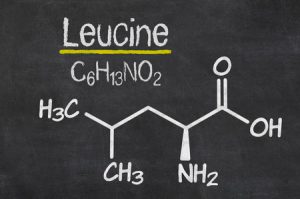Proteins are indeed the building blocks of the body. Personal trainers who understand the role of protein in resistance and aerobic training can best advise their clients for optimal results.
What is Protein?
Proteins are essential parts of organisms and are involved in virtually every process within cells. Many proteins are enzymes that catalyze biochemical reactions and are vital to metabolism. Proteins also have structural or mechanical functions, such as actin and myosin in muscle and the proteins in the cytoskeleton, which form a system of scaffolding that maintains cell shape.
Other proteins are important in cell signaling, immune responses, cell adhesion, and the cell cycle. Proteins are also necessary in our diets, since we cannot synthesize all the amino acids needed and must obtain al the essential amino acids from foods. (Note: Amino acids are the building blocks from which proteins are made.)
Through the process of digestion, ingested protein is broken down into free amino acids that are then used in metabolism. Proteins contain 4 calories per gram. This is an average, as each protein is slightly different (range roughly 3.5-4.5). Of the 22 amino acids involved in human nutrition, 9 are termed “essential” because they cannot be made by the body and therefore must be supplied daily in the food we eat.
The rest, which the body can synthesize, are called “non-essential.” The essential amino acids are leucine, isoleucine, valine, lysine, threonine, tryptophan, methionine, phenylalanine and histidine.
A complete protein is a source of protein that contains an adequate proportion of all of the essential amino acids for our dietary needs. This does not refer to the protein source only containing all the essential amino acids, but also containing them in adequate proportion for use by the human body.
A source may contain all essential amino acids, but contain one in lower proportion to the others, making it an incomplete protein. Most animal sources and certain vegetable sources have the complete complement of all the essential amino acids in adequate proportions.
Generally, proteins derived from animal foods (meats, fish, poultry, cheese, eggs, yogurt, and milk) are complete. However, proteins derived from plant foods (legumes, grains, and vegetables) tend to be limited in essential amino acids. Thus, a variety of protein sources in the diet is one way of assuring that the body’s amino acid needs are met.
All the essential amino acids can be obtained on their own from various everyday plant sources, which do not need to be combined in the same meal. The Protein Digestibility Corrected Amino Acid Score (PDCAAS) is a method of evaluating protein quality based on both the amino acid requirements of humans and their ability to digest it.
Complete protein foods that obtain the highest possible PDCAAS score of 1.0 are proteins from milk sources (caseinates), egg whites, and soy protein isolate. Other foods, such as amaranth, buckwheat, hempseed, meat, poultry, soybeans, quinoa, seafood, and spirulina also are complete protein foods, but do not obtain a PDCAAS score of 1.0.
The Role of Protein in the Body
The role of protein and amino acids in building body tissue is well established. Amino acids are the end product of ingesting protein. Amino acids are used for three basic functions in the body:
- They provide material for body tissue repair and synthesis.
- They are the synthesis of hormones, enzymes, and blood proteins.
- They provide for energy through deamination.
Specific amino acid combinations are predetermined through genetic nitrogenous base coding to be synthesized into living body tissues, muscle tissues, hormones, and blood proteins.
While other specific amino acid combinations are synthesized by the liver into the very enzymes and hormones that convert free amino acids, body protein and fatty tissue, into energy through deamination and catabolism.
Deamination is the removal of an amino group, NH2, from an organic compound. It is the process by which amino acids are broken down if there is an excess of protein intake. This process takes place primarily in the liver. It is important to note that whenever energy is produced, some amount of amino acid deamination is unavoidable.
It is equally important to realize that free amino acids are available in the bloodstream for 3-4 hours for combining with other amino acids for the uptake and synthesis of body tissues.
If after this approximate length of time, amino acids are still free in the bloodstream, they will be degraded and/or deaminated by liver enzymes into energy. This amino acid deamination results in the toxic bi-product ammonia, which the liver then converts into urea nitrogen for excretion. The amino group is removed from the amino acid and converted to ammonia. The rest of the amino acid is made up of mostly carbon and hydrogen, and is recycled or oxidized for energy.
Enzymes convert ammonia to urea or uric acid through the addition of carbon dioxide molecules in the urea cycle, which also takes place in the liver — and is not a deamination process. Urea and uric acid can safely diffuse into the blood and then be excreted in urine.
How Much Protein is Too Much?
The most accurate way of determining sufficient protein intake is to closely monitor the nitrogen intake (16% of all protein is nitrogen), and then compare this amount to the excreted nitrogen through Urinary Urea Nitrogen (UUC) testing.
For adults, nitrogen-in should match nitrogen-out.
If you are losing less nitrogen than you are consuming in food, you are retaining protein. Retaining protein is normal for kids who are growing or for someone who is building muscle through strength training. But, losing more nitrogen than you consume means protein-rich tissue (mostly muscle), is breaking down.
There are many potential causes for this, such as illness, stress, or chronic inactivity. The current recommendation for protein intake for healthy adults is 0.8 g protein per kilogram of body weight per day. This number was determined using studies on healthy young adults. But consider that body composition changes as people get older.
There are two primary metabolic conditions during which a high protein level exists:
- In the presence of sufficient total calories, a level of protein intake that is greater than the body’s need will likely result in a positive nitrogen balance, but at the expense of overstressing the liver, which is already charged with breaking down the toxin ammonia into urea for excretion. The greater the excess amino acids the harder the liver has to work. Overabundant amino acid presence in the blood accelerates metabolism and more water is lost during these increased chemical reactions, possibly causing dehydration in varying degrees. An alternative to decreasing the protein intake under these conditions is the consideration of increasing the intensity of exercise. This will minimize the excess circulating amino acids. The best way to optimize protein intake is through UUN testing and then altering resistance training intensity.
- In the absence of sufficient calories, whether protein ingestion is high or not, a high level of circulating “broken-down” body proteins and resulting amino acids will result in a negative nitrogen balance, as well as the liver’s production of keto acids, which are toxic to brain function. This, low-calorie, overabundant amino acid presence is clearly a more critical metabolic situation than when total calories are sufficient, as mentioned earlier, and it is undesirable regardless of health and fitness goals. This situation occurs during prolonged and extreme dieting.
Of course, any fat loss goal and takes a back seat whenever health is threatened. Maximizing fat loss results does sometimes call for a substantial restriction of total calories, however, using acetate testing (similar to UUN testing), adjustments to total calories can be made that result in a less threatening trace measurement of acetate.
It is important to keep in mind that increasing protein intake while also reducing carbohydrate intake with fat loss in mind will have positive fat loss effects, since amino acid deamination constitutes more work and accelerates metabolism. However, it is not suggested to maintain an extremely low calorie, high protein intake for periods longer than a few weeks. Increased water intake must be an integral part of this short-term dietary fat loss measure.
How Much Protein Is Too Little?
In the presence of sufficient total calories, low protein ingestion will not easily accommodate the building of new tissue. It becomes important, if one is ingesting little or no protein, that energy needs are being completely provided by ingested carbohydrates and fats, thus allowing what few amino acids are present in the blood to be synthesized from body proteins to include muscle tissues.
While it is known that several natural complex carbohydrates contain protein, it is acknowledged that several essential amino acids are missing from these carbohydrates.
Once adults pass the physical prime of their teens and 20’s, they lose an average of 10 ounces of lean body mass a year. This is mostly in the form of muscle tissue. Few people actually lose 10 ounces of weight a year. Instead, most gain about a pound a year, so the loss of lean tissue is masked.
Another way to look at this is the average person gains about 1 pound and 10 ounces of body fat per year. This phenomenon, called sarcopenia, is derived from Greek words for “vanishing flesh.” This change in body composition contributes to impaired wound healing, loss of skin elasticity, and an inability to fight infection.
An article in the July -August 2006 Journal on Nutrition and Aging reported that data from published nitrogen balance studies indicate that, a higher protein intake of 1.0 – 1.3 g/kg/day is required to maintain nitrogen balance in the healthy elderly. The researchers proposed that contribution of muscle protein to whole-body protein metabolism was significantly reduced with age and explained by reduced muscle mass and lower rates of myofibrillar protein turnover. Consequently, the contribution of nonmuscle protein, especially that of visceral tissue whose rates of protein turnover are known to be more rapid was proportionally greater with aging.

This research suggests that higher protein consumption rates could compensate for the decrease in availability of muscle amino acids and spare the muscle mass. Higher protein intakes for the elderly, and especially the frail population, than those presently recommended for younger adults may minimize sarcopenia and in so doing protect against some of the health risks of aging.
To meet the recommendation of 0.8 g/kg/day for a younger adult, a 150-pound person would need about 54 grams of protein per day. To meet the minimum recommendation of 1.0 gram/kilogram body weight for the older adult (> age 50) a 150-pound person would need about 68 grams of protein per day.
An ounce of lean meat, chicken, or fish has about 7 grams, a cup of low-fat milk 8 grams, an egg about 6 grams, and an ounce of cheese about 6 grams. If the person ate two 4-oz servings of meat per day plus an egg or glass of milk, then his/her total protein would be about 68 grams. The diet of an older adult that contains a large amount of bread, pasta, cooked vegetables, juices, and sweets could easily end up being low in protein. Diets of any age group that consist mainly of fast foods or processed foods are often lacking an adequate amount of protein.
When too little protein is being ingested and intense resistance training is performed, catabolism is prolonged and a long-term negative nitrogen balance can be expected.
In most cases, when ingested proteins are insufficient even for the required synthesis and repair of vital blood proteins and organ tissues, the body uses catabolic enzymes to degrade existing ‘low priority’ body tissues using their bi-products as building blocks instead. Since antibodies, for example, are among these ‘unneeded’ body tissues that are cannibalized, the body’s immune system can suffer as a result.
In the absence of sufficient total calories, while performing little or no strenuous activity, it is likely that few amino acids will escape the deamination process. In addition, the synthesis of protein-based hormones, enzymes, blood proteins, and various body tissues will be compromised. The performance of strenuous resistance exercise under these low-calorie, low-protein dietary conditions will likely result in the continued cannibalism of various structural body tissues including muscle and organ tissues.
Optimizing Protein Intake
In an effort to maintain a “positive nitrogen balance” (ingesting more nitrogen than excreting), the intention should be to provide a steady flow of ingested protein (every 3-4 hours), consisting of a wide variety of amino acids allowing for all possible combinations.
Thus, ensuring the continued synthesis of body tissues, proteins, and enzymes (positive nitrogen balance). It is important to realize that amino acids are most effectively spared from the process of deamination in the presence of sufficient blood-glucose energy that results primarily from carbohydrate ingestion. So long as protein intake is sufficient, the ingestion of more total carbohydrate calories will contribute to a positive nitrogen balance.
In addition, similarly to glucose, insulin must carry amino acids into muscle tissues, and carbohydrate ingestion causes insulin release, so it would make good sense to ingest proteins with carbohydrates to optimize insulin-carried amino acid uptake and utilization in body tissues.
All protein foods have varying Protein Efficiency Ratios (PERs), with milk and egg proteins rating highest on the list of “complete” proteins. The steady provision of protein throughout the day will generally result in a positive nitrogen balance. Where activity is concerned, the greater the intensity and duration of resistance exercise, the greater the required protein ingestion.
Suggestions for Optimizing the Role of Protein
For those who are not currently training for size and strength, consider letting the level of activity dictate protein intake. For example, if someone trained today at a greater intensity than usual, then consider ingesting additional proteins every 3-4 hours. If exercise intensity was somewhat low today, then concentrating protein intake will not be as important.
For an endurance athlete performing aerobic activity for 60 + minutes, consider the ingestion of proteins rather than carbohydrates during the activity. Protein ingestion may act to maintain blood sugar levels longer.
For those on a fat-loss program, there are a number of factors that must be taken into account. Designing a proper diet protocol is critical as it will help minimize the risk of losing lean muscle mass, suffering from incredibly low energy levels, or finding that strength starts to drop off in the gym.
Part of designing a proper diet plan is making sure that you take into account your overall protein intake. Protein intake requirements will vary considerably depending on who is doing this diet, so it’s a factor that needs to be looked at into greater detail. Let’s go over what you should know.
The Role of Protein in the Lean vs. Overweight
The very first and leading factor to take into account here is how much total body fat you have to lose. The point of difference to know is that leaner individuals who have only a few pounds of fat to lose and who are pushing the barriers on getting down to very low levels are going to be those who need to increase their protein intake considerably more.
The reason for this is that their bodies are more inclined to start utilizing protein as a fuel source since there is less stored body fat available. The leaner your body gets, the more reluctant it’s going to be to give away the one tissue that can help sustain it during starvation – body fat, so the harder it’s going to fight you to keep losing weight.
If you are significantly overweight, your body has plenty of stored reserves to live off of for quite some time, so the role of protein as an energy source is much diminished and it is more likely to use fat as fuel.
Volume of Exercise
The more one exercises, the more tissue is damaged increasing the need for more protein to repair it. Any more than two to three full-body workouts in the gym while dieting, increasing protein intake will provide the nutrients muscles need to repair and grow.
The Intensity of Calorie Deficit
Finally, the last thing that needs to be addressed is the intensity of the calorie deficit. The lower calorie intake is while dieting, again, the more prone the body will be to turn to protein as an energy source.
For best results, aim to keep the calorie deficit between 250 to 500 calories per day. Going over and beyond that is where you are more apt to see problems occurring.
Taking into account the nature of the diet, lifestyle, how much weight needs to be lost, and past diet history, rest assured that you are going to be designing things properly.
References & Additional Reading:
1. http://weightloss.about.com/od/eatsmart/a/Protein-How-Much-Should-You-Eat-To-Lose-Weight.htm
2. http://www.acaloriecounter.com/diet/how-many-calories-should-i-eat-per-day-to-lose-weight/
3. http://www.ncbi.nlm.nih.gov/pubmed/19927027
4. http://www.womenshealthmag.com/weight-loss/protein-weight-loss
5. http://breakingmuscle.com/nutrition/how-much-protein-do-you-need-science-weighs-in







